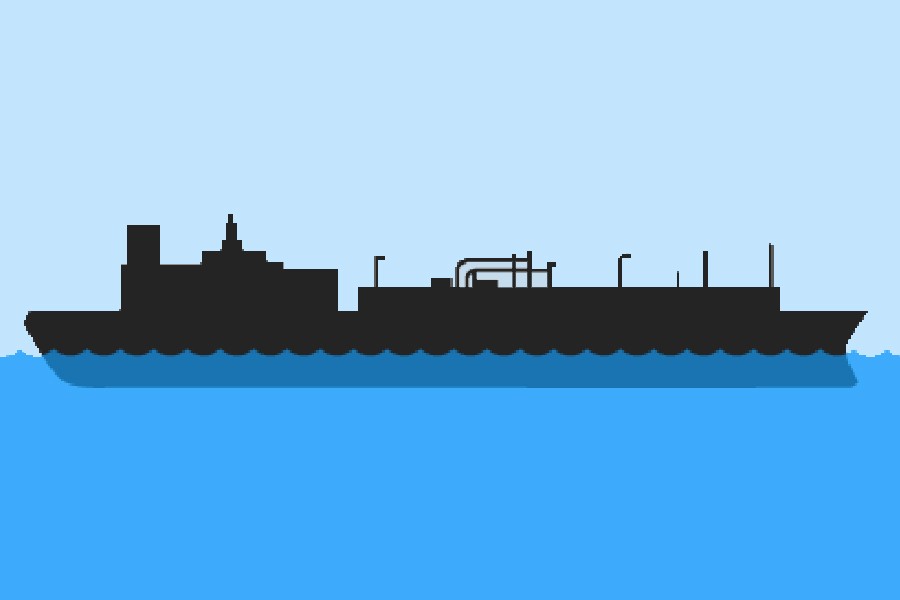The gas crisis has been a thorn perpetually pricking Bangladesh economy since 2005-6. During the early days of the crisis, the shortage of gas affected mostly power generation leading to six to seven hours of power outages during the scorching summer all over the country.
As the demand for power and gas increased over the next few years, the situation further worsened. Many small factories in and around Dhaka and Chattogram had to be closed down.
To tackle the problem, the government initiated steps through gas rationing. As households in some areas of Dhaka and other cities were not getting adequate supply of gas, gas supply to filling stations were stopped during certain slots of the day.Still the problem persisted. The government then decided to import liquefied natural gas (LNG) in 2010.
At long last, the first shipment of liquefied natural gas (LNG) arrived at Moheshkhali LNG terminal on April 25 this year. Around 133,000 cubic metres of LNG for supplying re-gasified LNG was brought from Qatar aboard a Floating Storage and Re-gasification Unit (FSRU) that anchored near the Moheshkhali Island in the Bay of Bengal.
The process of converting the liquid to gas, channelling it to the mainland, then to the national grid and eventually to the nearby cities for distribution is rather complex. The imported liquid has to be gasified and then pumped through a 91-kilometre long undersea pipeline connected to the Anwara grid. A pipeline, to be ready by May, will channel the gas from Anwara to Sitakunda. It is hoped that Chattogram would be able to use the imported gas within the next month.
The first shipment of LNG is undoubtedly a historic moment, especially for the energy-starved industries and households of Chattogram, which were severely hit by energy crisis since 2009.
As of January 2018, daily gas supply in the port city fluctuated between 180 and 220 million cubic feet per day (mmcfd) against a peak demand for 400-plus mmcfd.
From this quantity, the power sector was getting less than 100 mmcfd per day against a daily demand of 150 mmcfd, and fertiliser sector 87.6 mmcfd against the demand of 115. Other sectors like readymade garment, steel re-rolling, domestic, commercial and CNG filling stations were receiving gas in the range of 90 to 110 mmcfd against a total demand of 126 mmcfd.
While the import of LNG will hopefully open the doors to new gas connections for industrial units and power plants under Karnaphuli Gas Distribution Company (KGDC), one must not forget that gas is coming with a hefty price tag.
The import bills for the first two months will be paid from the Tk 35 billion Gas Development Fund. After that, the import will be paid through gas sales, which will lead to hikes in domestic pricing.
Already, gas suppliers have requested Bangladesh Energy Regulatory Commission to increase gas prices by 75 per cent to Tk 12.95 per cubic metre from the existing Tk 7.39 per cubic metre. BERC had raised gas prices last by about 22 per cent on an average in two phases during 2017.
The price of LNG per cubic feet will be near the range of Tk 14.90 per cubic feet (pcf), against the prevailing rate of Tk 8.10 pcf.
This, in turn, will push the price of power and increase the cost of doing business. While this will hurt the industries sector, there will of course be other nagging problems for the common man like the increase in the prices of essentials services. Hence, this issue needs to be brought under serious scrutiny.
It would be appropriate for industrialists and businesses to plan for effective ways through which these added costs could be reduced. Such plans would be especially necessary for export-oriented industries like the readymade garment, leather and others. The factories which continue to produce for foreign buyers need to keep their prices competitive so that they do not lose their market to competitors from other countries.
While the government is negotiating with four other suppliers on long-term and short-term deals and spot purchases of LNG, policy-makers and think-tanks need to explore feasible alternatives that can reduce the pressure on gas.
Industries can also become more energy-efficient. Efforts for offshore oil and gas exploration can also be geared up. Improved infrastructure can be another option besides increasing storage facilities for gas. Finding sustainable and efficient ways to pool and use solar and wind energy is also a viable option.
Alternative sources of energy need to be considered seriously along with people's access to those and safe use by them at this point in time. It would be unwise to allow the crisis to worsen further with our increasing dependence on imported sources of energy.


